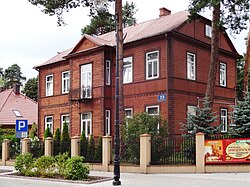Otwock
Otwock | |
|---|---|
 Świdermajer-styled house in Otwock | |
|
Masovian Voivodship in east-central Poland, some 23 kilometres (14 mi) southeast of Warsaw, with 44,635 inhabitants (2019). Otwock is a part of the Warsaw metropolitan area. It is situated on the right bank of Vistula River below the mouth of Świder River. Otwock is home to a unique architectural style called Świdermajer .
It is the capital of Otwock County. The town covers the area of 47 square kilometres (18 sq mi). Forested areas make up 23% of the territory, and there are several nature reserves. History Even though the first mention of a village called Otwosko comes from the early 15th century, Otwock did not fully develop until the second half of the 19th century, when in 1877 the Chłopi there. The Zofiówka Sanatorium was opened in Otwock in 1908. In 1916, Otwock was incorporated as a town and became the seat of a powiat .
During the Battle of Warsaw (1920), Otwock, along with nearby Karczew, constituted the edge of the right wing of the first line of Polish defense and was manned by the Polish 15th Infantry Division, whereas the second line of Polish defense began in the present-day neighborhood of Świdry Wielkie; however, there was no Polish-Russian fighting in Otwock.[1] In 1936 railway connection Warsaw - Otwock was electrified as the first rail line in Poland. World War II Following the German–Soviet  Otwock is the hometown of Righteous among the Nations by Yad Vashem. Writer Calel Perechodnik, a Jewish Ghetto Policeman from Otwock also hailed from this town. Following the liberation, a children's home for Holocaust survivors was established in Otwock.[6]
Post-war periodIn 1952, town limits were expanded by including Świder, Świdry Wielkie, Teklin and Zamlądz as new neighbourhoods.[7] Following the Korean War, in 1953–1959, Poland admitted 200 North Korean orphans in Świder.[8] From 1975 to 1998, it was administratively located in the Warsaw Voivodeship. SightsIn Otwock there are many buildings in the Świdermajer style, unique to the town and its surroundings. There are also memorials to Józef Piłsudski and to local Jews, who were murdered by Nazi Germany in the Holocaust. The Mszar Pogorzelski, Świder and Wyspy Świderskie nature reserves are located in Otwock. EconomyIn 1958, Ewa, the first Polish nuclear reactor was activated in Swierk district of Otwock. A second research reactor, Maria, was erected in 1974. SportsOtwock is home to a sports club Legia Warszawa and the national team of Poland.
 International relationsTwin towns – Sister citiesOtwock is twinned with:
References
External links
|

